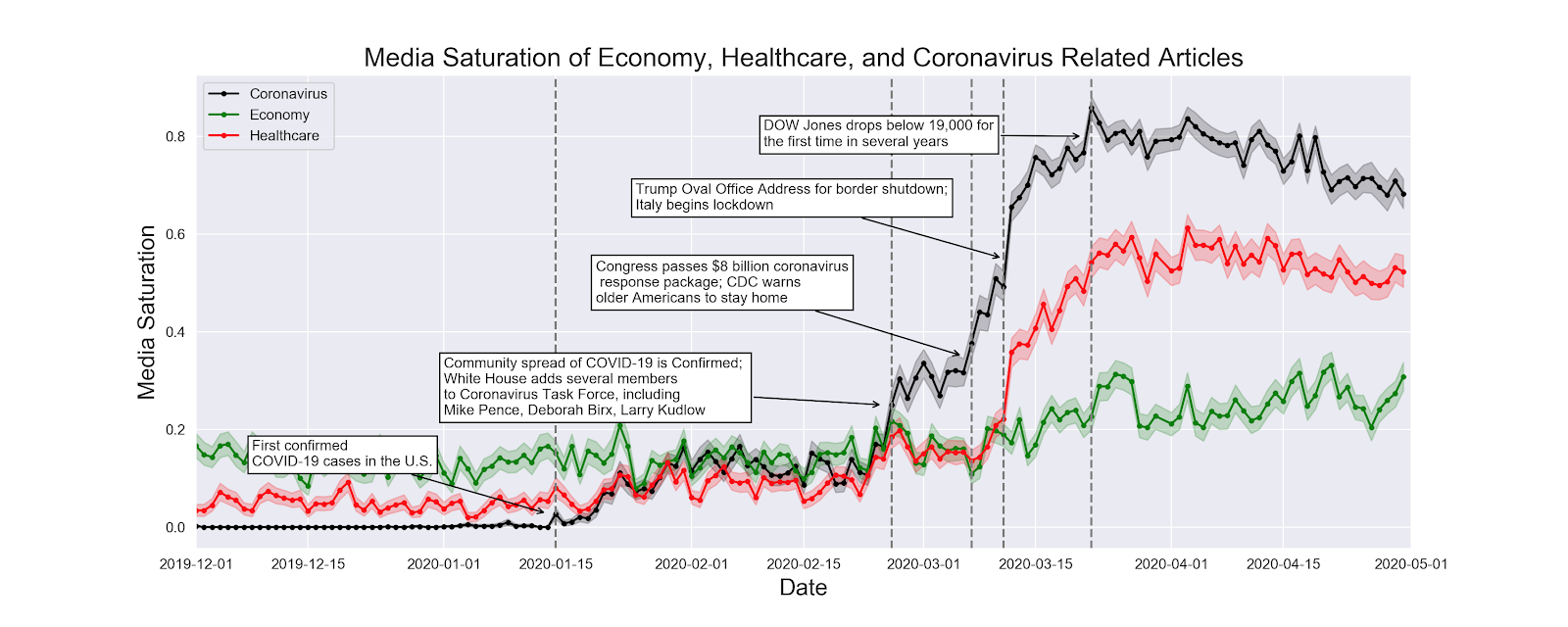
Identifying Media Trends during the Coronavirus Pandemic
In late 2019, doctors in Wuhan, China reported a strange pneumonia-like illness caused by a mysterious virus for which none of the normal medications seemed to work. It soon became known that this illness was caused by a novel coronavirus - a virus that humanity has never been exposed to and against which nobody has any pre-existing immune defenses. By March, the spread of the virus was global.
As of mid-April, there have been over a million and a half cases of COVID-19, with over 100,000 deaths worldwide. The global pandemic has unleashed wall-to-wall news coverage as well as ubiquitous attention from blogs, social media posts, YouTube videos, and journal articles. Schools, colleges, and universities have sent their students home to continue their studies online, millions of workers have been laid off or furloughed, and claims for unemployment benefits have skyrocketed to unheard of levels. Social distancing is the new buzzword as flyers, ads, and videos urge people to stay home.
Throughout this pandemic, the media has been not only a means of conveying important information to families across the country, but also an important measuring tool that reflects how we as a society are reacting to this situation. At PeakMetrics, we've examined a broad range of media produced since the start of the outbreak and searched for trends that might give us some indication of how people are responding. To do so, we pulled over 135,000 English-language online written news articles from a wide range of both local and national scale media outlets published since December 1, 2019.

We found that the media saturation of articles related to the COVID-19 pandemic peaked at around 0.9. In other words, about 90% of news media produced on that day was related to the COVID-19 pandemic. The COVID-19 media saturation increased gradually throughout January and February as COVID-19 cases started to appear in the US, and then sharply increased in March due to a variety of social, political, and economic consequences of the pandemic.
Furthermore, the focus of the attention throughout March has been less on the economic impacts of the pandemic than the medical and healthcare impacts. While the prominence of articles on the state of the economy rose notably, the discussion of healthcare-related articles rose considerably more. The exceptionally large number of applications for unemployment benefits and a volatile stock market are important and newsworthy topics. However, the media has prioritized reporting on topics such as medical equipment shortages.

Nevertheless, this trend may be changing. The overall media saturation of coronavirus-related articles and healthcare-related articles has seen a steady decline since the peak of saturation in late March. On the other hand, the media saturation of economy-related articles has steadily risen. Furthermore, individuals such as New York Governor Andrew Cuomo and Dr. Fauci from the National Institute of Health have generated less media coverage in recent weeks. This may be a sign that the media is starting to change focus more towards the economy. This could have serious implications for our societal response to COVID-19, as there have been numerous lockdown protests in recent weeks over concerns about the economy. If we as a society are becoming more lax about social distancing restrictions, then it could lengthen the overall duration of the pandemic.


Our survey also included an analysis of the overall sentiment of the media being produced. Articles were labelled on a continuous scale from -1 (negative) to 1 (positive). While there are day to day variations, the media as a whole exhibited a slightly positive sentiment. Interestingly, media articles related to COVID-19 begin below the overall media average offset and gradually regress towards the media average.
There are numerous factors that may contribute to these trends. First, our survey only included nonvisual material and sentiment labelling only accounted for the words in the body of each article. A large portion of the media that might contribute positively or negatively was not considered. This includes, for example, news media video clips. Next, the media saturation of COVID-19 increased dramatically over the past four months. It is possible that the large increase in the number of COVID-19 articles reduced the day-to-day variability in the average sentiment of articles. And third, the continuous news coverage of the COVID-19 pandemic might be somehow causing the coverage to be normalized in the written reporting. That doesn't mean that media producers aren't taking the pandemic less seriously as time goes on - it only means that they might be writing about this very unique situation in a way that is stylistically consistent with more typical news reports.
While interesting media trends can be identified pertaining to the COVID-19 pandemic, it is worth noting the limitations of these results. This survey only focused on English-language online written articles, and the sentiment analysis used a binary system (positive / negative) that doesn't capture a wide range of varied nuanced sentiments.
Furthermore, caution should be taken when attempting to equate the media reporting with public opinion. For example, the media has tended to focus more on the medical consequences of the pandemic over the economic impacts. That doesn't automatically mean that the general public is more focused on the economy than on the healthcare system (though there is a strong argument to be made that they are and should be). Some people might be genuinely more worried about their employment prospects than about getting sick. These sorts of questions would be better addressed with an opinion poll.
Despite these limitations, the trends we found do provide some insight into our societal response to the pandemic. When we take action (or fail to take action), the media recognizes it. As shown above, the rise from 0 to 80% media saturation didn't occur gradually. There were a number of pivotal moments where the saturation spiked and continued increasing, at milestones which can be identified. How will COVID-19 play out in the media in the near future? It depends on how we respond to the challenge.
Article by Dominick Hing
Photo by Kelly Sikkema on Unsplash
Request a free report
Uncover emerging narratives around your brand, industry, and competition.
Sign up for our newsletter
Get the latest updates and publishings from the PeakMetrics investigations team.